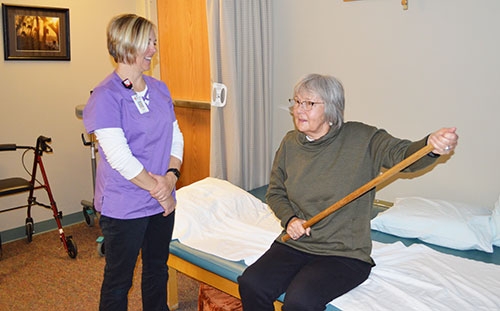You are here
Home ›April is Occupational Therapy Month: OT treatment proven for help with side effects after cancer treatment

Occupational Therapy at VMH ... April is National Occupational Therapy Month. Occupational Therapy is proven to help with side effects following cancer treatments, such as Lymphedema and joint mobility. Pictured above is Occupational Therapist Tami Gebel, at left, assisting cancer survivor Pam Delphey of Waukon, at right, with exercises to help improve her shoulder mobility. Submitted photo.
Lymphedema is the chronic or persistent swelling of a body part due to an obstruction of the lymphatic system. The lymphatic system lies underneath the skin and works closely with the blood circulation system as it transports fluids throughout the body to lymph nodes. While in the lymph nodes, the fluid is “cleaned” of bacteria, viruses, and other unwanted materials. The “clean” fluid is then sent to the blood and re-circulated throughout the body.
Lymphedema occurs when the lymphatic system is damaged and unable to move the fluid, therefore the fluid collects in the body part and swelling develops. Lymphedema can cause problems such as decreased ability to move the arms or legs, decreased strength, impaired sensation, difficulty walking, fatigue and overall inability to complete daily activities such as dressing, bathing, cooking, cleaning, and other work tasks. Lymphedema can be treated by an occupational therapist.
Pam Delphey of Waukon is a 15-year breast cancer survivor who has been seeing Tami Gebel in Occupational Therapy for help with side-effects following her very successful cancer treatments. Pam was diagnosed with breast cancer in 2007 and following surgery, she received weeks of radiation and chemotherapy. She states that she was very fortunate enough to be able to continue working while receiving these treatments.
In 2015, Pam noticed her left arm was becoming larger in size due to swelling, which caused the left arm sleeve of her shirt to be tight. Tami used manual lymph drainage massage to help move the fluid out of the left arm, and instructed Pam in use of low stretch bandages during the day and a nighttime compression garment to keep the swelling out. Tami recommended a pneumatic lymphedema pump which mimics manual lymph drainage massage that Pam was able to use at home daily. Towards the end of her therapy, Pam was fit with a lightweight compression sleeve that she still wears today. Pam religiously continued her exercises at home and wore the compression sleeve every day. With these methods, Pam’s lymphedema has been very manageable.
Pam returns to Tami whenever needed for other side-effects of her successful cancer treatment, currently including left shoulder limited mobility.
“Tissues can typically tighten up after radiation which limit movements of a joint,” explains Tami. “Pam’s shoulder has limited motion due to her surgery and cancer treatments, so we work on special stretching and strengthening exercises. I see many patients following cancer treatments that need the same type of treatment, with great success.”
“I would encourage others to come here for this type of help following treatments,” states Pam. “This has definitely been helpful.”

